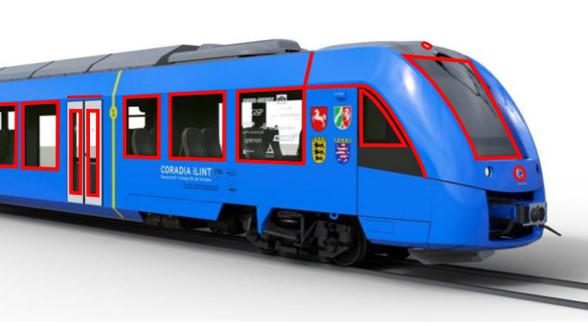The energy turnaround is a major topic of the current time. There are many starting points for this, such as optimisation in mobility. After all, who hasn't heard of it: it takes 20 minutes by car to get to work, and an hour in public transport. So who chooses the more environmentally friendly option of public transport? Alstom has addressed this problem and, with the help of bonding technology, has developed a train construction that - compared to diesel vehicles - works with an alternative, environmentally friendly drive technology.
Why do we need alternative drive technology?
There are several reasons for optimising and introducing new drive technologies. For example, a large part of the railway network is not electrified, which makes the use of electric trains impossible. In contrast to diesel vehicles, emission-free trains contribute to an environmentally friendly mobility solution while being quieter. This alternative to fossil fuels is also good for the wallet, as the price of diesel is expected to continue to rise in the medium and long term. In addition to the climatic conditions, the acceptance of diesel vehicles in urban areas is also declining - a compliant technology facilitates the social and political debate.
Energy and mobility turnaround with Coradia iLint
Dipl.-Ing. (FH) Florian Roncossek is an European Adhesive Engineer and FVK specialist at Alstom. He and some of his colleagues have completed various further training courses in the field of bonding and fiber composite technology at the Fraunhofer IFAM. With the knowledge gained from this, they have now been working on the Coradia iLint project since 2014. Coradia iLint is a passenger train that uses a hydrogen-based drive system - the first of its kind in passenger service worldwide. A hydrogen fuel cell generates the electrical energy for the drive and thus enables local emission-free transport, as the train only emits water vapor and condensation.
With this new concept, Alstom is enabling a more environmentally friendly and sustainable train operation, which is already in operation: In 2016, two pre-series vehicles were produced, which received approval in July 2018 and have been successfully in scheduled service with passengers in Lower Saxony since September 2018. Fleet operation is scheduled to start in 2021/22, and up to 41 vehicles of this type will then be running on rails in NIedersachsen and Hessen.
What does this new solution have to do with adhesive bonding technology and the Fraunhofer IFAM?
Rail vehicle construction is one of the industries where bonding technology is used - as in the Coradia iLint project. As is already the case with well-known diesel trains, bonds are used for floors, side windows, roofs and entrance doors in the body of the new train. But they are also present in the interior fittings, for example on the floor, on the seats or in the step rails. A wide variety of adhesives are used for this purpose: elastic adhesives, hot melt adhesives, dispersion adhesives, contact adhesives, 2-component reaction adhesives, pressure-sensitive adhesives and others. In addition to adhesive bonding technology, fibre composite technology also comes into play here, since lightweight construction is important and is becoming increasingly important in mobility.
In addition to the well-known adhesive bonding points on the train, however, bonding technology also plays a decisive role, especially when one looks at the process of regenerative energy generation. So-called power-to-gas systems are used to operate the Coradia iLint. These convert excess electricity generated in a regenerative and thus emission-free manner into hydrogen, which in turn requires wind turbines, the production of which would not be possible without bonding technology.
Bonding technology is thus an important key technology for regenerative energy generation and the path to new, innovative mobility concepts.
